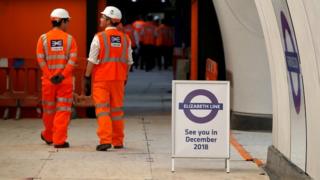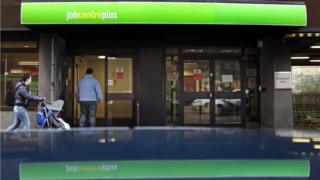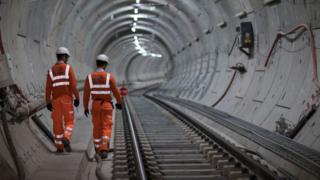 Image copyright HS2
Image copyright HS2The government has approved the controversial High Speed 2 (HS2) rail project – designed to link London, Birmingham, Manchester and Leeds. The project has encountered numerous problems, with a review warning costs could double to as much as £106bn.
But HS2 is far from alone when it comes to projects that have gone over their initial budget.
Here are three very different examples.
Crossrail
 Image copyright Reuters
Image copyright Reuters
Crossrail – a rail line running through central London – was meant to open in December 2018. But after a series of delays, the line is not expected to fully open until mid-2022.
The service, between Berkshire and Essex, via central London, is now set to cost £18.25bn – more than £2bn over the original budget.
Although the work on the 26 miles of new tunnels was completed in 2015, the project has been hit by software problems with the new signalling system.
At the same time, work on the Bond Street and Whitechapel stations has taken much longer than originally planned. Crossrail said Bond Street’s opening had been delayed “because of design and delivery challenges”.
For example, the wrong mix of concrete was poured into the station in 2012, which had to be replaced.
Last year, a report by the Commons Public Accounts Committee found an “unacceptable” lack of accountability over the delays, although the Department for Transport rejected this claim.
Universal credit IT system
 Image copyright Getty Images
Image copyright Getty ImagesUniversal credit, the government’s plan to change the benefit system by replacing six existing payments, suffered numerous early setbacks.
These included an IT system that struggled to cope and was prone to crashing.
In 2013, the National Audit Office (NAO) – which scrutinises public spending for Parliament – found almost three-quarters of the cost of setting up universal credit had gone on the IT system, with significant sums written off.
One problem with the IT system, identified by the NAO, was that it couldn’t identity potential benefit fraud. This meant staff had to carry out multiple manual checks, which took up a lot of time.
The issues with the IT system led to the postponement of the national rollout of the scheme.
Universal credit is not expected to be fully live until September 2024, adding £500m to the overall cost.
Scottish Parliament building
 Image copyright Getty Images
Image copyright Getty Images
The Scottish Parliament building opened its doors in 2004, with a hefty price tag.
Problems around the cost, design and delivery eventually led to a public inquiry, led by Lord Fraser, involving 66 witnesses.
The building was three years late and the cost had spiralled to £414m, more than 10 times the original 1997 estimate.
John Campbell, the counsel to Lord Fraser’s inquiry, said the scheme had suffered a management failure of “gigantic proportions”, with civil servants, politicians and the construction managers all to blame.
When he delivered his verdict, Lord Fraser said there was no single “villain of the piece” but he was astonished ministers had been kept in the dark over cost increases.
He also said it was far too late in the day before anyone appreciated the scale and complexity of the proposed design.
“It verges on the embarrassing to conclude, as I do, that virtually none of the key questions about construction management were asked,” he wrote.
The initial £40m estimate “never had any basis in reality” and quality had been prioritised over cost throughout, according to the report.
In a separate report, Audit Scotland said lessons must be learnt. It said much greater care should be taken in choosing contracts and that project risks must be better understood.
Why do government projects run into problems?
Historically, most major governments projects haven’t delivered on the promises of their initial cost-benefit analysis, according to a 2013 National Audit Office (NAO) report.
The NAO blamed “over-optimism” and said many projects started off with unrealistic assumptions about the time, costs and risks involved.
But this problem isn’t unique to the UK, according to Nick Davies from the independent Institute for Government think tank.
“Nine out of 10 mega-projects around the world (where costs are over £1bn) go over time and over budget,” he says.
 Image copyright Getty Images
Image copyright Getty Images
Meg Hillier, who chairs the Public Accounts Committee, a group of MPs that examines how government spends public money, says: “There’s often a lot of political pressure to make an early announcement and this means it’s a bit of a back of an envelope when it comes to initial costings.”
Changes in ministers and senior civil servants can also add to the problem, according to Mr Davies.
“Churn means you lose expertise, especially as it take a good six months to get up to speed,” he says.
Even when ministers stay in the same job, projects often disappear from their desks once the initial decision to proceed has been made.
“When it goes wrong it’s often late in the day,” says Ms Hillier.
“Politicians need to know when something is going wrong at an earlier stage”, she adds.

Three other expensive projects
 Image copyright Getty Images
Image copyright Getty Images- Channel Tunnel – One of the biggest engineering projects undertaken in the UK. While it transformed travel from London to Paris and Brussels, the project was beset by delays and spiralling costs. When the tunnel opened in May 1994, it was one year behind schedule and £2bn over budget.
- Edinburgh tram line – By the time trams hit Edinburgh’s streets in 2014, the project was five years late and had cost £776m (double the original estimate). Disagreements led to a standstill for several months. When construction finally resumed, it created gridlock because of a “catastrophic failure” of traffic management.
- Millennium Dome – Opened to mark the new millennium, the dome was heavily criticised after it only attracted 50% of the predicted 12 million visitors. Closed at the end of 2000, the government faced initial difficulties trying to sell the vacant site, costing taxpayers £1.8m a month in upkeep. The Dome was eventually redeveloped into an entertainment complex and rebranded as the O2 in 2005.

How can government manage projects better?
In an effort to tackle some of these issues, the government has created the Infrastructure and Projects Authority (IPA). Run by infrastructure experts, the authority oversees the delivery of major projects.
Last month, the head of the IPA, Nick Smallwood, said there had been recent successes such as the 30-hour free childcare programme and the cleaning-up of Sellafield and other historical nuclear sites.
But he also acknowledged that “we can do better“.
Teaching more people in government how to handle complex projects was one solution favoured by Mr Smallwood. Since 2012, some 2,000 people had received training, he said.
So has the IPA’s work made a difference?
Mr Davies says government departments have been reasonably positive about the IPA’s work and the advice it gives. But to make a real difference, he says, governments need to do a better job at learning lessons from past projects.
“If you know that road junctions tend to go over by 10%, that can really help when it comes to budgeting current projects,” he says.
“But it’s much harder to do this when it comes to mega-projects, because there are so few of them.”
Original Article : HERE ;
from MetNews https://metnews.pw/why-do-big-projects-cost-more-than-planned/
No comments:
Post a Comment